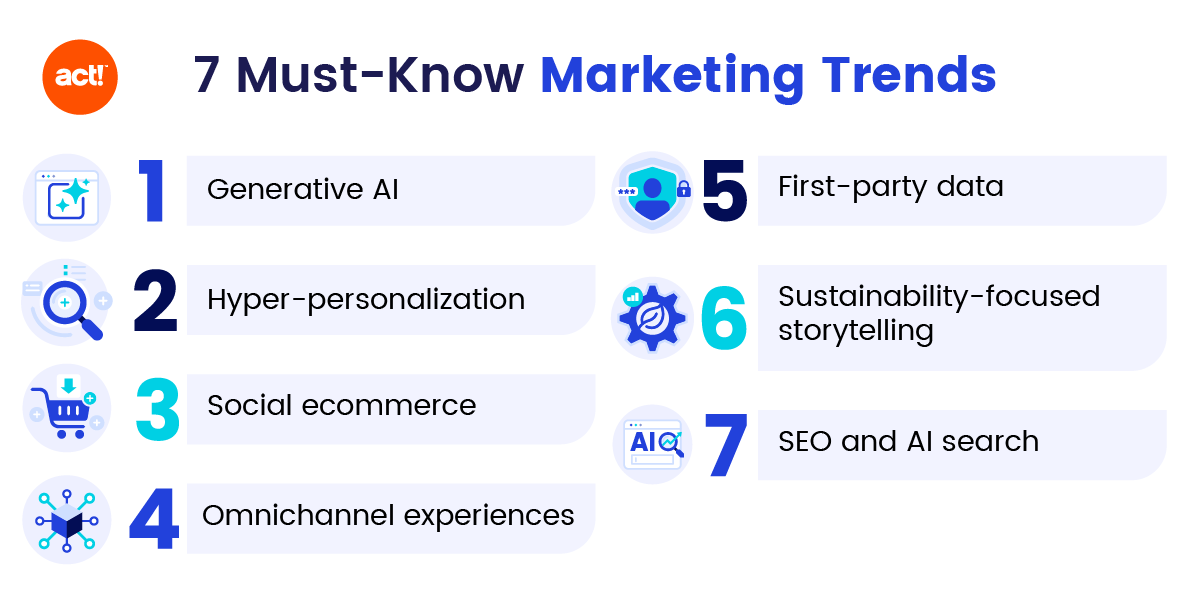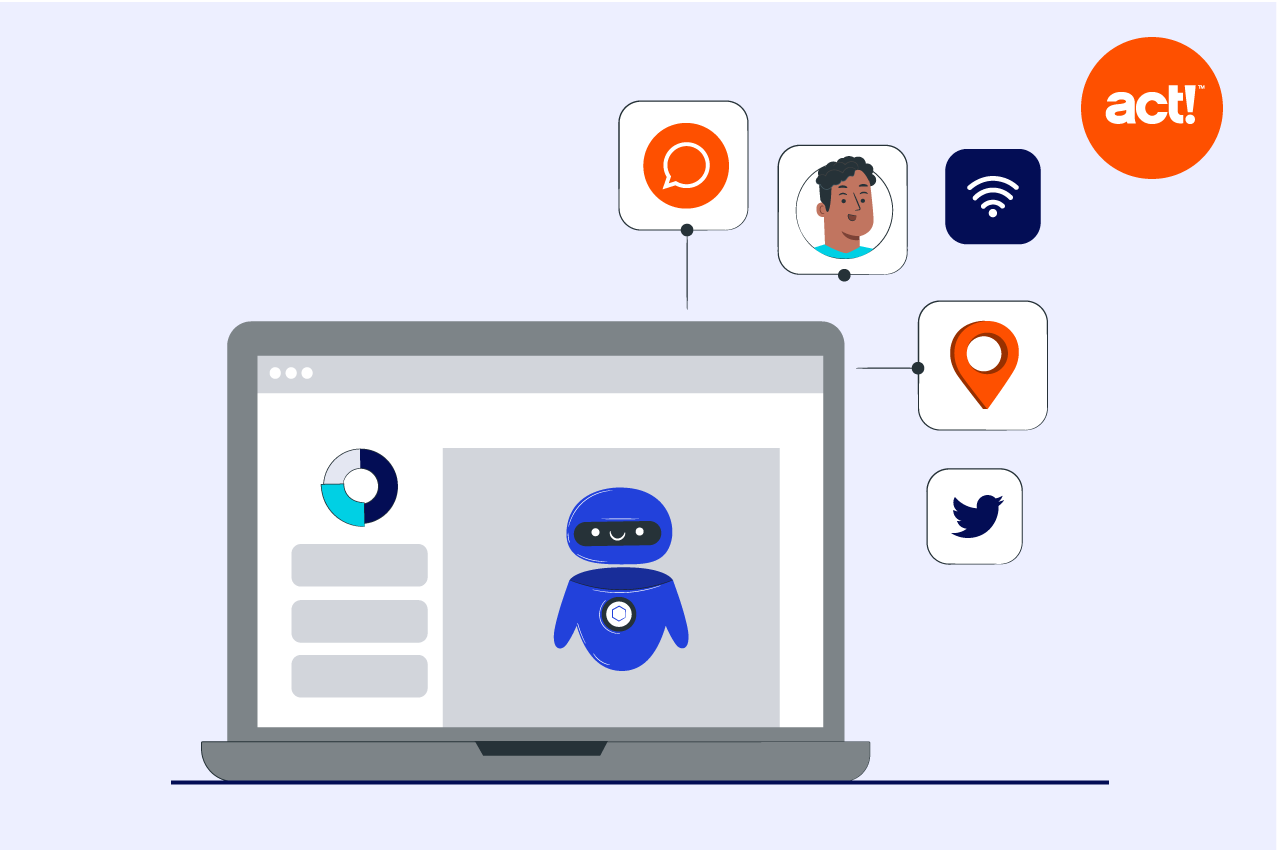
BlackBerry, Nokia, Kodak, Toys “R” Us—what do these companies have in common?
They were once industry leaders but couldn’t keep up with the competition. Ultimately, they failed to innovate fast enough as market dynamics and consumer preferences evolved.
How do you ensure your business doesn’t meet the same fate? By staying on top of the latest marketing trends.
Today, marketing is changing faster than ever with breakthroughs in AI, shifts in consumer trust, and the emergence of new channels.
From AI-powered hyper-personalization to the growing demand for seamless omnichannel experiences, the way brands connect with their target audience is undergoing a massive shift.
In this blog, we’ll look at the current marketing trends and discuss ways to build a future-proof strategy for your SMB.
1. Generative AI
We can’t discuss new marketing trends without mentioning generative artificial intelligence (GenAI). Case in point: 71% of marketers use AI to deliver personalized customer experience.
Using AI tools for marketing offers several benefits, including improved efficiency, personalization, and targeting. These tools are particularly useful for creating high-quality content in multiple formats at scale.
It isn’t surprising that 68 percent of marketers have a positive attitude toward GenAI. The use cases extend beyond AI-generated content and automation, with 59 percent of marketers excited to see the application of AI to ads.
Additionally, you can use GenAI to power your content marketing campaigns by tailoring content based on real-time data, such as online behavior and regional preferences. Think personalized product recommendations based on a customer’s location or purchase history.
There’s a catch, though. Thirty-six percent of marketers believe their teams don’t have adequate skills to leverage these tools to drive their marketing efforts. This necessitates investment in training programs that help marketing teams adapt to GenAI tools and other emerging technologies.

2. Hyper-personalization
Personalization is the surest way to attract attention and build trust.
Research by Deloitte shows that 75 percent of consumers are more likely to buy from brands that deliver personalized content. Younger generations are particularly drawn to personalization. A full 26 percent of Gen Zers favor brands that offer customized products.
Personalization takes more than just segmented email marketing campaigns and ads. The key is to use AI to deliver targeted content and product recommendations in real time based on previous interactions and purchases.
Additionally, offer customized loyalty rewards that reflect individual purchase habits to make these programs more effective. Ask customers for feedback and use it to tailor recommendations and rewards.
3. Social ecommerce
Did you know that 29 percent of consumers learn about new brands and products from social media ads? It’s no surprise then that 69 percent of videos created by marketers are social media video content. Short-form videos, in particular, are popular, with numerous brands using Instagram Reels, YouTube Shorts, and TikToks to their advantage.
But building brand awareness on social media isn’t enough. You also need to deliver a seamless, mobile-friendly purchase experience after a consumer comes across your brand/product.
With social media platforms like Instagram and TikTok offering in-app shopping features, it’s high time to hop on the social commerce bandwagon. Besides paid ads, it’s a good idea to invest in influencer marketing campaigns. Identify creators (both mega and micro-influencers) whose interests align with your brand values and get them to publish content highlighting your products.
Creator-led content helps businesses stand out, with 78 percent of consumers trying brands/products featured in these posts. Prioritize shoppable posts, like the one below, as they help consumers discover and purchase products in an organic way.

Image via Instagram
Another smart idea is to host livestreaming sessions where you can showcase your products and address customer queries in real time.
4. Omnichannel experiences
Consumer preference for hassle-free purchases isn’t limited to social media. Delivering a cohesive and consistent user experience across offline and online channels is a must.
For example, it’s common for shoppers to switch between desktop and mobile devices while searching for products on a brand’s website. But many such buyers end up purchasing the product in a physical store.
Omnichannel shopping experiences—from in-store pickups and availability checks to real-time offers—help brands satisfy changing consumer needs and stand out from competitors. Here’s an example from IKEA, showing real-time availability of a product in stores.

Image via IKEA
Identify key touchpoints across the customer journey, collect important data, and integrate it into a centralized location like Act! CRM to increase conversions.
Use it to understand individual customer preferences and create hyper-personalized experiences. Maintain consistent branding across different channels to improve brand recognition and build trust.
Omnichannel also applies to other areas of your business. For example, customers prefer connecting with the same support agent, regardless of the channel they use. This helps you offer a consistent customer experience and gathers priceless customer behavior data to optimize your marketing strategy.
5. First-party data
With the phasing out of third-party cookies and stricter data privacy regulations, marketers need to turn on first-party data. From app and website interactions to gated content and loyalty programs, there are several ways to collect data directly from customers.
Besides ensuring compliance with GDPR, CCPA, and other laws, this approach demonstrates transparency and builds consumer trust. Plus, it facilitates more accurate personalization.
As consumers grow more privacy-conscious, businesses that adopt privacy-first technologies and ethical data practices will gain a competitive advantage and improve their data-driven marketing.
6. Sustainability-focused storytelling
Sustainability has moved from novelty to business imperative, with some consumers willing to pay 9.7 percent more for sustainably produced or sourced products.
With rising consumer expectations, brands must integrate sustainability authentically into their marketing campaigns. Transparency in sourcing, carbon reduction, and ESG initiatives is key to building trust and loyalty.
Storytelling can amplify these efforts by showing real impact and milestones. Highlighting concrete actions, such as shifting to renewable energy, achieving carbon neutrality, or supporting ethical sourcing, can showcase impact while inspiring consumer advocacy.
Add stat callout
7. SEO and AI search
The introduction of AI platforms has caused a tectonic shift in the search landscape. Even behemoths like Google have added AI snippets to search engine pages to answer user queries quickly.
Does that mean SEO is no longer needed? Not really.
AI only drives about 0.17 percent of the average website’s traffic, much less than search engines. But if you pair it up with the increasing number of AI snippets in searches, you have a lot at stake.
And that’s why it’s important to include SEO strategies in your overall digital marketing strategy. Your content creation should focus not just on ranking in searches but also target LLMs so they drive referral traffic to your website.
Some of the tactics you should employ to rank in search engines include:
- Do voice search optimization for questions users may ask AI chatbots using voice.
- Use clear messaging and natural language. Write for readers and not search engine algorithms.
- Create structured content with clear headings and paragraphs.
- Back all claims with evidence from high-authority websites and case studies.

What digital marketing trends have you recently adopted?
Marketing isn’t about hopping on every new trend. It’s about embracing the right trends that align with your target audience’s needs and interests. That said, keeping an eye out for hot trends in marketing is non-negotiable.
As technologies like generative AI continue evolving, the marketing landscape will change at lightning speed. The brands that thrive will be those that innovate with purpose, adapt quickly, and put people at the heart of every campaign.
Also central to every marketing campaign? Data. You need access to relevant, updated customer info. And with Act!, you have it at your fingertips. Try our CRM and marketing features free for 14 days.





